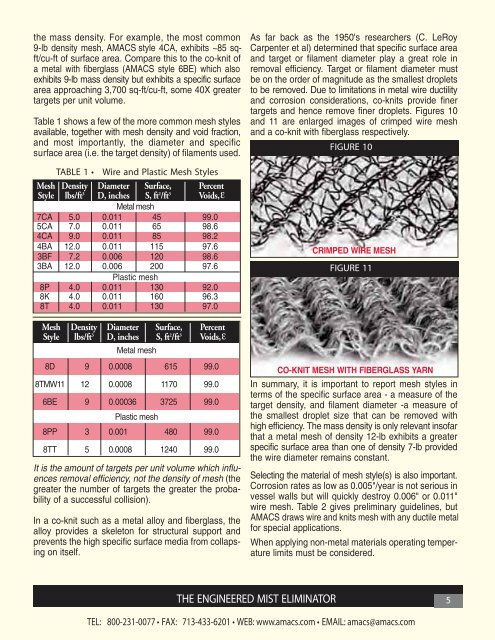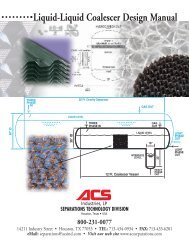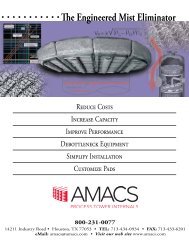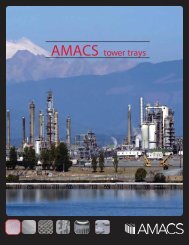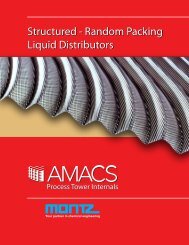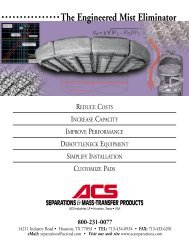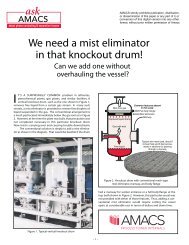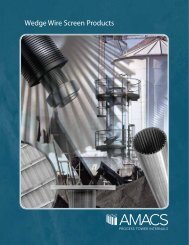Mesh and Vane Mist Eliminator Brochure - AMACS Process Tower ...
Mesh and Vane Mist Eliminator Brochure - AMACS Process Tower ...
Mesh and Vane Mist Eliminator Brochure - AMACS Process Tower ...
Create successful ePaper yourself
Turn your PDF publications into a flip-book with our unique Google optimized e-Paper software.
the mass density. For example, the most common<br />
9-lb density mesh, <strong>AMACS</strong> style 4CA, exhibits ~85 sqft/cu-ft<br />
of surface area. Compare this to the co-knit of<br />
a metal with fiberglass (<strong>AMACS</strong> style 6BE) which also<br />
exhibits 9-lb mass density but exhibits a specific surface<br />
area approaching 3,700 sq-ft/cu-ft, some 40X greater<br />
targets per unit volume.<br />
Table 1 shows a few of the more common mesh styles<br />
available, together with mesh density <strong>and</strong> void fraction,<br />
<strong>and</strong> most importantly, the diameter <strong>and</strong> specific<br />
surface area (i.e. the target density) of filaments used.<br />
As far back as the 1950's researchers (C. LeRoy<br />
Carpenter et al) determined that specific surface area<br />
<strong>and</strong> target or filament diameter play agreat role in<br />
removal efficiency. Target or filament diameter must<br />
be on the order of magnitude as the smallest droplets<br />
to be removed. Due to limitations in metal wire ductility<br />
<strong>and</strong> corrosion considerations, co-knits provide finer<br />
targets <strong>and</strong> hence remove finer droplets. Figures 10<br />
<strong>and</strong> 11 are enlarged images of crimped wire mesh<br />
<strong>and</strong> aco-knit with fiberglass respectively.<br />
FIGURE 10<br />
TABLE 1 • Wire <strong>and</strong> Plastic <strong>Mesh</strong> Styles<br />
CRIMPED WIRE MESH<br />
FIGURE 11<br />
It is the amount of targets per unit volume which influences<br />
removal efficiency, not the density of mesh (the<br />
greater the number of targets the greater the probability<br />
of a successful collision).<br />
In a co-knit such as a metal alloy <strong>and</strong> fiberglass, the<br />
alloy provides a skeleton for structural support <strong>and</strong><br />
prevents the high specific surface media from collapsing<br />
on itself.<br />
CO-KNIT MESH WITH FIBERGLASS YARN<br />
In summary, it is important to report mesh styles in<br />
terms of the specific surface area - a measure of the<br />
target density, <strong>and</strong> filament diameter -a measure of<br />
the smallest droplet size that can be removed with<br />
high efficiency. The mass density is only relevant insofar<br />
that ametal mesh of density 12-lb exhibits a greater<br />
specific surface area than one of density 7-lb provided<br />
the wire diameter remains constant.<br />
Selecting the material of mesh style(s) is also important.<br />
Corrosion rates as low as 0.005"/year is not serious in<br />
vessel walls but will quickly destroy 0.006" or 0.011"<br />
wire mesh. Table 2 gives preliminary guidelines, but<br />
<strong>AMACS</strong> draws wire <strong>and</strong> knits mesh with any ductile metal<br />
for special applications.<br />
When applying non-metal materials operating temperature<br />
limits must be considered.<br />
THE ENGINEERED MIST ELIMINATOR 5<br />
TEL:<br />
800-231-0077 • FAX: 713-433-6201 • WEB: www.amacs.com • EMAIL: amacs@amacs.com


